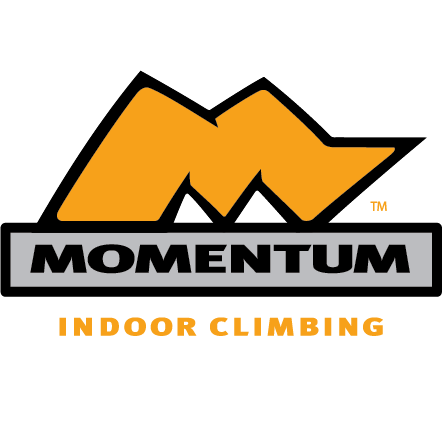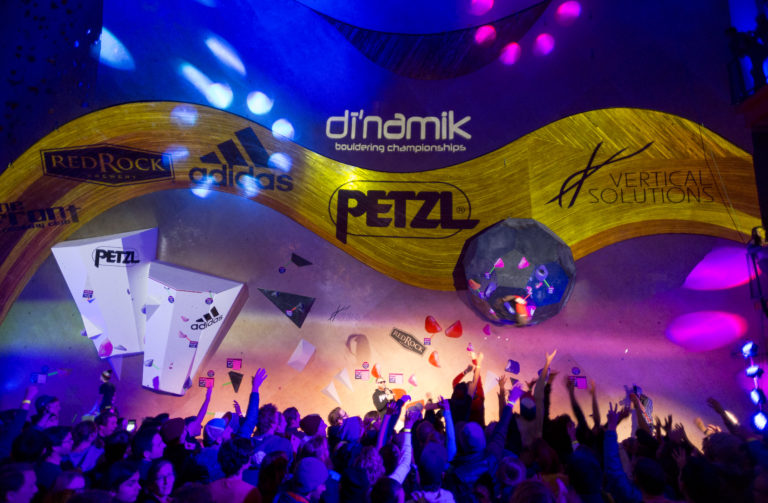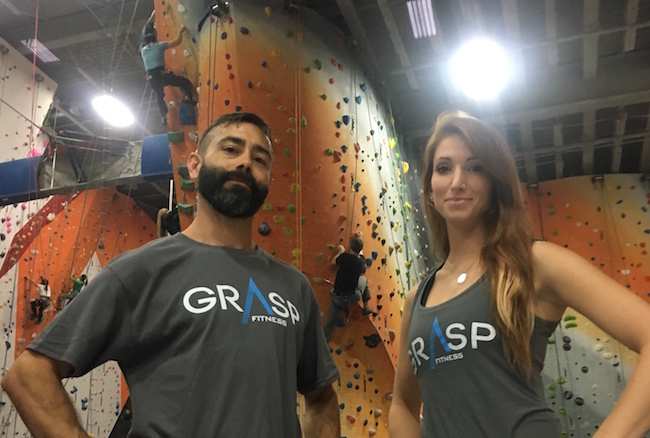Earth Treks Announces Maryland Move
Earth Treks New Columbia Gym – Opening 2017 from Earth Treks on Vimeo.
Earth Treks’ original gym, which opened in 1997, in Columbia, Maryland will soon be replaced by a 38,000 square foot climbing and fitness facility that is quadruple the size of the current space. The new gym will be housed in the same building where the current facility is located just in a different section of the building.
The design will include, what ET says is, the largest bouldering area in the state and up to 28,000 square feet of climbing. Also included in the design:
“Twenty years ago we opened the Columbia climbing gym as a club house for our friends. It is so gratifying that from that small space, we’ve grown such a big community of climbers. Now, with five gyms spread from Columbia to Colorado, we’ve become one of the biggest operators in this industry. We now have more than three hundred employees and serve more than one million customers each year. With all the memories created in that facility, it will be sad to shut down the gym. But at the same time, we’ve learned so much about operating climbing and fitness centers that it is exciting to give our members and staff a bigger, brighter and in every way better new club house,” said Chris Warner, Earth Treks founder and CEO.
Earth Treks’ current Columbia facility (located at 7125 Columbia Gateway Drive) will remain open until the new facility is complete ensuring a seamless transition for all members.
Flashback To The Beginning
80's Throwback to Vertical World and the First Climbing Gym In…
A #throwback to 1988 – a year after the first gym in the US was opened and having its first competition. Back when climbers were noids, lycra was totally radical to the max, glued on rocks were primo, big hair and one ear earrings were righteous, and top roping 16' was diesel. **Bonus rare footage of originial Founders Richard Johnston and Dan Cauthorn!
Posted by Vertical World Seattle on Thursday, February 2, 2017
Chris Warner’s Rules for Leadership

By Abree Murch
The leadership guru, John C. Maxwell once said that a leader “is one who knows the way, goes the way, and shows the way.” Following this mantra is Chris Warner, founder and CEO of Earth Treks, Inc. and all-around bad ass. Warner has had both a literal and figurative foot in all three of those areas at one time or another.
He is an accomplished climber and mountaineer who has led multiple expeditions on Everest and K2. He also teaches at the Wharton School of Business and advises organizations on leadership strategy, including Google, the Baltimore Ravens, and the US National Counterterrorism Task Force. CBJ sat down with Warner to get his thoughts on leadership in the indoor climbing industry and what climbing gym owners and operators can do to ensure their organizations are performing to their full potential.
The State of Leadership in the Climbing Industry
According to Warner, climbing gyms have an education problem: most people in leadership positions have never been formally trained. “Our leadership education tends to be a little more intuitive than it is intellectual,” Warner says. “We typically model behaviors that we see in other people. The problem with this idea is that quite often we’re taught how to lead by people who have never been taught how to lead.”
The modeling approach can become doubly destructive when leaders start modeling outdated behaviors. “There’s a big difference between someone who’s in their twenties now and someone who’s in their fifties now,” explains Warner. “I learned to lead from people who had a very engineering-based focus on the world. We were trying to make things more productive and more efficient.” Now, he says, leaders should be looking to an approach that parallels Maslow’s hierarchy of needs. The upcoming generation has moved beyond just being fed and clothed, and are looking for self-actualization, purpose, and meaning as components of their work life.
This phenomenon of intuition-based leadership paired with an outdated approach is one that afflicts many small to mid-sized businesses. Warner feels it’s particularly common in the climbing industry, but it’s something that can easily be addressed through training: “Until gym owners – and anybody running a mom-and-pop type business – really start to study leadership experts, until they’re properly coached, they’re just going to perpetuate the same problem.”
So where can gym owners, operators, and managers start?
Take an honest look in the mirror
Warner acknowledges that this is usually the hardest part for most leaders, but it’s the most critical. Edward Deming, one of the great early leadership thinkers, theorized that 80-95% of all problems within companies are caused by management. Warner agrees, estimating the true percentage to be closer to 80%, adding that “we know that 70% of businesses lose money or break even every year in the US. Only 1% of businesses gross over $10 million in sales. So there’s something that’s stopping these businesses from being successful.”
Warner likes to use the TV series The Office to illustrate why these 70% of businesses aren’t succeeding. He maintains that most businesses, including climbing gyms, have the same flawed pyramidal structure the show portrays. At the top of this hierarchy is the person who owns and/or runs the organization, a la Michael Scott. “In that spot, you also can write the word ’sociopath’,” says Warner, “because ultimately, what is a sociopath? Someone who believes the rules don’t apply to them.” He points out that this describes a lot of climbers: “We celebrate this – just look at the ‘dirtbag lifestyle’.”
At the very bottom of the pyramid are the economic “losers;” these might be the staff members who work without benefits for minimum wage or volunteer routesetters. However, Warner warns that while these people at the bottom may be seen as economic losers, “they’re pretty damn smart and heaven help the person at the top if they organize, because they will come after you with pitchforks!”
So the owner/operator of this flawed organization is forced to build in a bunch of clueless middle managers as a buffer between them and the people at the bottom. These middle managers are clueless because they don’t see what’s truly happening in the business and they’re not willing to question the sociopath at the top.
This, Warner says, is the model of business who break even or lose money every single year: a flawed leader at the top, people at the very bottom who suffer because of this flawed leadership, and a bunch of people in the middle who are clueless and don’t know how to identify or fix the problem. True change hinges on key leaders acknowledging their faults and that they may be the person at the top of the pyramid.
Realize gyms are in the business of behavior
To operate a climbing gym that counts itself in the 30% of businesses that make money, Warner points to three drivers of results: “One is you bring the right tools – you build the perfect gym in the perfect location. Second, is the techniques – you apply sound financing and accounting techniques, and follow industry practices. Thirdly, is the behaviors of the organization, the behaviors of your staff.”
For the most part, climbing gyms are all competing with the same tools and techniques. The holds, ropes, and walls all come from the same places, and the basic technicalities of running a gym don’t vary too much from place to place. Therefore, according to Warner, competition really occurs on only one of these fronts: behavior.
“On the behavior side, you can take a podunk little gym in a bad location and you can make a LOT of money because your team exceeds the other teams in the area.” He points to bars as an example. “How many bars are in your town? One bar is always going to be doing better than the other bars because their staff are friendlier, they’re better trained, etc.”
This is where all businesses need to understand that their greatest ability to drive results or profitability is in the behaviors of their staff. By extension, leaders within organizations have to learn what “mission-critical behaviors” their staff should have and what they can do to encourage those behaviors.
Hire the right people and don’t screw them up
In order to find and keep staff members that display these mission-critical behaviors, gym leaders need to have a conscious way of judging people. Warner recommends plotting existing and potential employees on a chart that maps a person’s ability to deliver strategic results against their alignment with the organization’s core values.
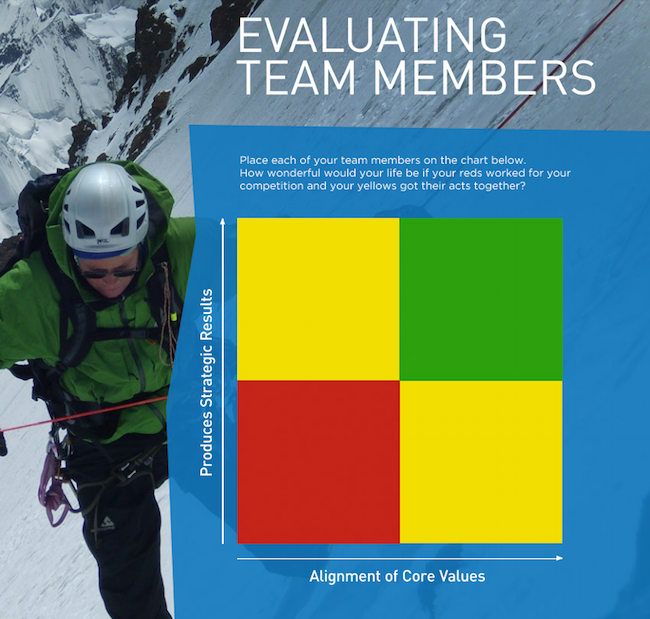
To be successful, a leader needs to cultivate the “green people” – team members that fall into the green section, who do their jobs well and add value to the team. New hires are usually already there and Warner asserts that “most people who work in climbing gyms are decent people.” So how do these good employees get screwed up? Usually, it’s a case of needs being unmet.
Warner cites six psychological needs that must be met in order for a person to perform optimally as part of a team:
“If you’re not taking care of those needs, you’re screwing people up,” he explains. For instance, a “green” experienced staff member is going to become demotivated and fall into the yellow or red if their need for growth isn’t met and they’re confined to the front desk even after they’ve mastered the position.
The need for autonomy works in a similar way. “The day someone starts to micromanage you, you become dysfunctional,” Warner explains. He cites Earth Treks’ decision to change their approach to front desk staffing as an example. Initially, staff had a never-ending to-do list of cleaning tasks, but they ended up being so busy that the quality of customer service suffered.
Now, his facilities staff more people while giving them less to do. Though over-staffing is one of the criticisms Warner receives to his face most often, it’s paid off and he sticks by his approach: “The thing is, if you’re bored at the front desk, you give great customer service because you’re desperate to do something other than be bored!”
In order to be sure they’re meeting their team’s needs, Warner advises leaders to create a spreadsheet listing their employees across the top and each of the six psychological needs down the side. Each week, leaders should judge themselves honestly on whether they’ve meet these needs for each employee, keeping in mind that the approach will likely vary from person to person.
Make hard decisions
Have you ever dealt with someone who is great at what they do, but absolutely miserable to spend time with? “There’s nothing worse than when you have someone who delivers strategic results but doesn’t align with your core values,” Warner says. These people can be incredibly toxic to organizations because leadership is reluctant to let them go.
There are other factors that can affect team member’s performance that are beyond anyone’s control. It’s plausible that someone is a good fit when they’re hired, but something happens in the 13th month of employment that causes them to lose their spark, from a car accident that changes their financial situation, to a divorce or break-up, to a death in the family.
So how do you know when it’s time to remove a member of the team? When a team member starts exhibiting performance problems, the first step is to honestly evaluate whether leadership is meeting the person’s six psychological needs. If it’s determined that the problem is related to an issue besides management, Warner suggests meeting with the person and seeing what can be done to support or coach them if needed.
From this point on, he subscribes to “The Rule of Threes”: if three or more people spend three or more hours working to fix the problem, but there’s little to no progress, that person needs to go. “If you don’t let them go, you’re actually hurting the situation,” Warner explains, “because an organization needs to be catering towards the ‘green people’.” It takes quite a number of meetings to reach the three-hour mark and doesn’t make sense to demotivate your existing team members by forcing them to suffer because one person has a problem that can’t be reasonably remedied.
Be adaptable
Good leaders will have the ability to tailor their leadership based on the size of their organization. Managers of smaller gyms have an advantage in that they can more easily get to know their staff members and lead in a large degree by example. As the size of the organization increases, however, that ability decreases. “When you get to an organization the size of Earth Treks with 300-plus, you cannot lead by example anymore,” explains Warner. “You also need to be aware of your place.”
For instance, if the CEO of a large gym chain witnesses a birthday party belayer make a minor mistake and confronts them about it, the weight of the CEO’s authority can blow the situation out of proportion. Instead, the CEO should go to the belayers supervisor and get them to talk to the person. “My job at Earth Treks when the organization gets to this size is to make people happy that they work for the company,” Warner says. “It’s definitely not to micromanage anybody.”
Warner encourages climbing gym owners and operators to become lifelong students of business leadership, even if they’ve never studied the concept before. “If this is your first job as a manager and someone tells you to go out and make people know you care, go out and do it poorly a thousand times,” he states. Team members would rather see leaders try to make positive changes than see no effort at all. As Warner says, “If your intention is good, then people will forgive you.”
Missoula Gym Expands, Adds Sport Climbing
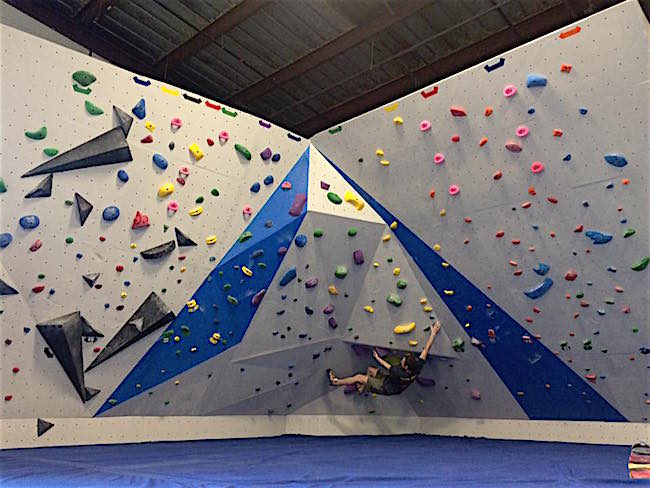
The first commercial climbing gym in Missoula, Montana is on track to get a lot bigger. Freestone Climbing, which opened in 2011 with 3,000 square feet of bouldering, has moved to a new space with over twice the amount of square footage.
Freestone owner, Walter Hailes told the Missoulian newspaper that after testing the waters with a bouldering-only facility he knew he wanted to add sport climbing. “We were looking for some place to put in a real ropes course, but there wasn’t anyplace tall enough,” Hailes said. “We had to build this.”
When Hailes first opened Freestone, he was nervous about the viability of a stand-alone facility. But, after a series of wall expansions, the 4,800-square-foot space that he started with quickly hit capacity.
The new space is now open but is not completed. Available to climbers right now is 3,500 square feet of bouldering while an additional 10,000 square feet of sport climbing is under construction. Hailes’ long-term plans include adding a yoga studio, weight room, stationary bikes and treadmills to broaden the facility’s appeal.
Start-Up Gym Consultation with Vertical Solutions
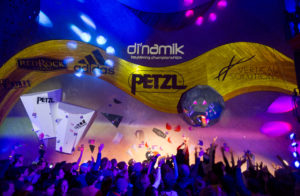
Most readers here are familiar with the industry growth that indoor rock climbing businesses have seen over the past 6 years. The Climbing Business Journal’s Annual Gyms and Trends report gives a detailed analysis of the state of the industry, and one observation consistently made by potential first-time gym owners is that every year sees increased activity from large gym brands opening additional gyms. Many existing climbing gym brands are expanding into new markets, while some are bolstering their presence in existing markets not yet fully saturated.
This expansion can create apprehension amongst first-time business partners looking to break into the industry when planning their first climbing gym. The thought of competing on a scale with larger industry-staple brands is intimidating and overwhelming. As was the case with a recent early-stage gym owner that felt lost as a small start-up in a sea of big and established gym companies, and was considering abandoning their plans altogether before landing on a partnership with the all-American climbing gym builder, Vertical Solutions.
Established Experience
The early years of the industry saw gym owners figuring their businesses out on-the-fly, with no prior model to adopt for success. The continued industry growth has witnessed a trend towards larger operations that require big-money and large scale professional construction sites, as compared to climbing gyms historically being boot-strapped businesses, mostly self-funded smaller scale DIY projects. These start-up gym owners felt that the larger operations set the precedent for climbing gyms of all sizes to perform as businesses and excel at being profitable. They needed an advantage to help them succeed, so they searched for a team that had established experience of owning multiple gyms, as well as experience creating small start-up gym successes for first-time proprietors.
After surveying the field, they landed on the new Vertical Solutions website which places emphasis on a holistic approach between the products and services they offer. Traditionally known for their highly-aesthetic curved and geometric climbing walls, the website isn’t limited to their work in climbing wall design and construction, but rather equal attention is placed on flooring system products, climbing hold products, an online climbing gym supply store, and — most importantly for them — a business consulting program.
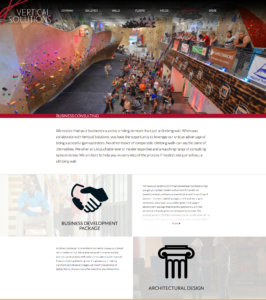
The consulting and company pages of VSClimbingGyms.com draws attention to the fact that they currently own and operate large-scale successful climbing gyms in Utah, and also that they began as small start-ups just like 90% of their clients. They assert that because of this, they can give your start-up business the advantage it needs to succeed. They highlight this 15-year history and data collection in small and large gym operations as being a main difference in approach to business consulting, and as a result they have developed a model for success that can be applied to a customer’s specific vision, no-matter the scale.
Superior Tools
It was clear to these future gym-owners that gone were the days of gym start-ups taking a casual approach to the requisite business planning and data analysis needed to create a productive business. So they took an in-depth look at the Sample Gym Financial Modeler Spreadsheet that is supplied for free on VSClimbingGyms.com, and gained confidence knowing that there are tools available to navigate the complexity in opening a climbing gym. They signed on to receive the Vertical Solutions Business Consulting package and started collaborating immediately to tailor the Financial Modeler to their business.

It was no short process, and more often than not the consultation conversations created more questions than answers in the first week. Aware that this was part of the development program, they started working tirelessly on refining their understanding of the challenges ahead. As part of the Business Consulting Package, this is just one of the tools that were applied to their market, goals, demographics, and general environment. Vertical Solutions worked to familiarize them with the conversations, business plan documents, and pro forma associated with the financial lending process to expedite funding success, among other things. Through these efforts, they accelerated the timeframe to reach milestones in the process to successfully open their gym doors.
Research then Development
The advisory role that more experienced businesses play can be integral to a new gym owner’s success and tremendously beneficial for small start-ups. If you are currently planning your first climbing gym, it is imperative to do your homework by researching companies that offer comprehensive services and Business Consulting Packages. The success of start-up climbing facilities in a world of big-league brands hinges on a comprehensive approach to serving your market, and it is important that you work with partners/product providers who understand that strategy from experience. The result produces a deeper integration and personal (even emotional) investment in your project, which gives you greater probability for success.
To jump-start the success of your new start-up climbing gym, inquire about the Vertical Solutions Business Consulting Package by visiting the Vertical Solutions website or reaching out to them for more information.
What It took To Make UK’s Fastest Growing Climbing Gym
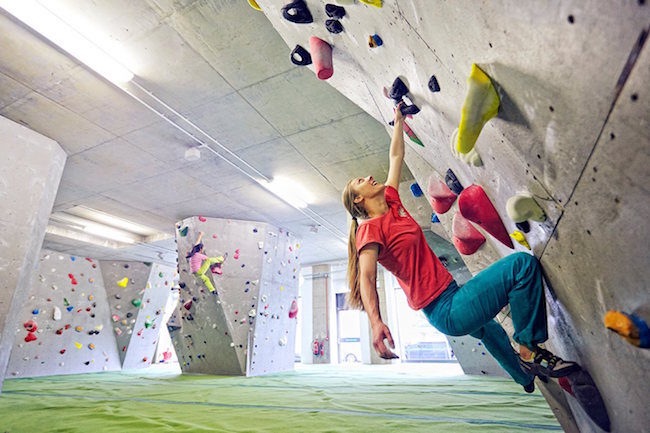
By:Zofia Reych
In the UK, the tradition of indoor climbing is strong. It’s said that the world’s first climbing wall was built in 1964 at the University of Leeds and with over five decades of the industry’s history, it’s not a surprise that some venues are considered iconic. High up on the list are The Climbing Works in Sheffield, known for its proximity to the country’s best bouldering and a crowd of pro and semi-pro climbers, and Mile End Climbing Wall in London, considered to be the first dedicated facility in Britain.
Recently, a new contender is moving quickly up the ranks, becoming a dominating force within the industry. The history of the Arch Climbing Wall spans less than a decade, but thanks to the vision of its director, the brand is developing faster than any other in the UK.
An accidental entrepreneur
Chilled and well spoken, Fred Stone is immediately recognizable as a climber. Even though he’s a businessman, a husband, and a father of two, it’s much easier to imagine him dirtbagging than closing business deals.
After graduating with a degree in French and Italian literature, he moved out to Egypt, but love brought him back to the UK. He settled in London with his wife to be, and one of his first jobs in the capital was route setting at Mile End Climbing Wall.
In 2007, with money invested by his father, Stone decided to try his hand at running his own gym. The only thing he needed was a venue, and what he found turned out to be something special. ‘It was a complete fluke’, he says. ‘I just walked into a whole lot of empty railway arches. I was walking around, thinking wow, this is amazing. And there was the landlord’s number scratched onto the wall with a pen.’
With an investment of some GBP100,000, and an immense amount of luck, Stone converted one of the Victorian arches underneath the tracks emerging from London Bridge station into the capital’s most central climbing wall. Finding the venue was like hitting the jackpot, yet the first couple of years were tough, “trying to pay the bills and keep sane,” he said. And even when the business finally picked up and Stone had paid off all his debts, the idyll was short-lived.

“We were forced to move out in 2011. Network Rail reclaimed all the arches for redevelopment. I really thought the wall was going to be where it was, to stay there. I didn’t see it outgrowing the space, or developing. At that point, any thought of expansion was still a nightmare, but as it turned out getting kicked out was kind of a blessing. It made a crossing in our road,” Stone said.
Stone was faced with a tough choice of walking away with money or reinvesting everything. He chose the latter and, after a brief hiatus, The Arch reopened in a new, sweet location: a disused Peek Freans biscuit factory. With over 10,000 sq ft of open space, the new Arch became what many considered to be London’s best and biggest bouldering-only climbing wall. And within only two years Stone announced the opening of a sister site, Building One in 2014. Less than a 15-minute walk from The Biscuit Factory, Building One is slightly bigger, and features a 60-ft high glass covered roof. The video ad announcing the opening of Building One was viewed over 75,000 times.
Arch Climbing Wall introduces Building One from The Arch Climbing Wall on Vimeo.
Every evening, both The Biscuit Factory and Building One are packed. And now, under the same membership, climbers are offered a third venue: Arch North in London’s northern district of Burnt Oak.
A people’s man
With three busy climbing gyms in the capital, you’d expect Fred Stone to be anxiously zipping back and forth between the venues. Nothing could be further from truth. Stone lives in Devon with his wife Roz and twin toddlers. Their house is by the sea, some 200 miles away from central London. It’s a good place to raise a family, and it allows Stone to pursue another passion – surfing.
“I compress all my meetings into a couple of days every fortnight. I don’t necessarily tell my business contacts that I don’t live in London; I just say, could we do it this day, or this time,” Stone said.
Leaving the business unattended would make your average director at least anxious, but as mentioned, Fred Stone is a chilled man. “I trust the people I work with. If I’m not around, they do their own thing and only come back to me if they’re really unsure about something,” Stone said. “Everybody who works under me, they can’t develop if they’re micro managed, or if I’m trying to do their jobs. It’s also not what the business needs to develop,” he went on to say.
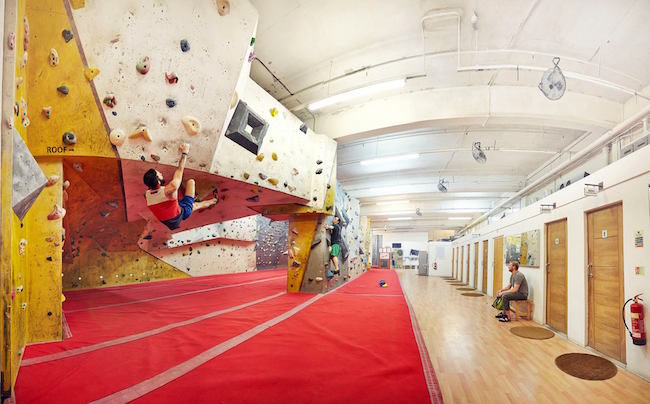
Asked about staff retention, Stone says it’s about respect. “Money also has to make sense, especially living in London. But for the young generation, it seems to be less of a deciding factor. Self-fulfillment is much higher on the agenda.”
Once a month all full-time employees have the option to take a paid day off and volunteer for a charity of their choice. “Having them feel like they’re fulfilled and happy is probably key to getting long life out of your staff,” he said.
“The counter will always have a reasonable turnover of staff and it’s totally cool, but if people stay, they can progress within the company. If somebody wants to take a long holiday, let them have it,” he said. “I’d rather have them come back and really feel at home within the business.”
One of the unique options available to Stone’s employees are routesetting courses which can be undertaken for free by all staff members. The hours are paid and the structured syllabus includes exams, practical tests, and a number of shadowing sessions.
“I’m trying to further the education,” said Stone. “We send our setters off for workshops and national qualifications. We try to get them involved in the industry as much as possible so that in five years time, someone who is now a routesetter at The Arch could develop into a role that doesn’t even exist now.”
At present, The Arch has an in-house team of four full-time routesetters headed by a manager. They are aided by a pool of part-time setters hailing from employees, as well as guest ‘star’ setters. However, Stone believes that investing in the in-house team is key.
As an example, Stone said: “Recently we invited Nicky [Niklas Wiechmann] from Stuntwerk in Cologne to do a workshop. His focus was very much on the creative, aesthetic, king line style of setting. I’ve taken from that a new approach based less on quantity and more on quality.”
To avoid having both setters and climbers getting hung up on grades, the problems are set in color-coded circuits spanning approximately two grades. Each of the three centres offers ten circuits of varying difficulty (from under V0 to over V8) at any given time, and to keep things fresh, setting is carried out four to five days a week.
Colors of circuits are consistent across all three facilities, meaning that a blue problem will always be somewhere between V1 and V3. However, to keep setters and climbers on their toes, the same colors are set with different holds at every venue. “For example, we bought a lot of red Kilter grips for The Arch North. At another centre, the red circuit won’t be the same holds.”
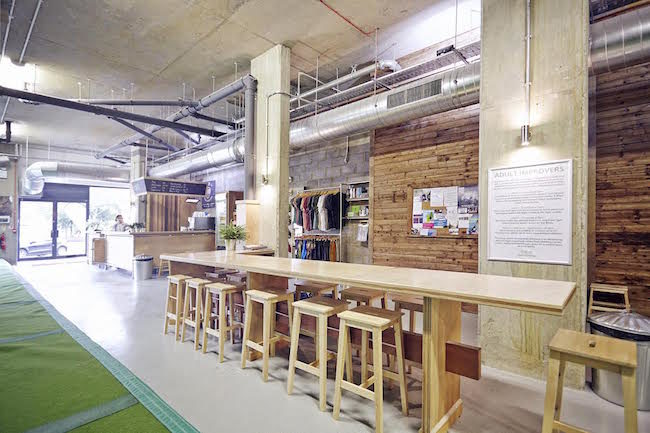
Core values
Quality setting is one of the key elements putting The Arch at the centre of the climbing community. Smart sponsorships are another way to strengthen the brand, and at the moment The Arch supports Fran Brown (World Champion para climber) and Matt Cousins (British Bouldering Champion).
Stone believes it is possible to cater for everyone in a way that’s not yet been done, and without creating a distinction between core climbers and other members of the public. “Part of it is the way the industry thinks of climbing, and maybe the slightly condescending feeling we have towards the non-climbers. But offering what the non-core climbers want is not about watering climbing down. It’s about distilling it and making it more accessible,” he said.
Every business decision is made on the basis of three key values: health, sociability and enjoyment. The three emerged in 2011 and now underpin The Arch’s unique identity as a brand and inform its development. Since moving out from London Bridge, none of The Arch’s venues were intended solely for climbers. There are parkour, calisthenics, yoga and circus skills classes taught at the gyms which also feature well-equipped bodyweight training areas.
“A lot of people within in the climbing industry forget that climbing is not the end goal of what we do. What I’m interested in is what happens when we stop chasing after climbing as the end goal, and just have it as a medium through which we work,” he said.
The values-based approach had an interesting effect on The Arch’s Monthly Roundup competition known as TAMRU. After starting out as a traditional comp involving rankings and prizes, it became an inclusive charity event that welcomes both beginners and pros. Competitors are still given score cards, but rather than points, each problem they climb equals a 50p donation made by The Arch to charity.
“We choose a different organization each month. The suggestions come both from customers and the staff. It’s a really nice thing, and it’s changed the atmosphere of the comps. We get people who may only climb two problems, and not because they’re lazy, but because it’s all they can climb out of the comp set. But it’s still a valid entry that still really equals something at the end of it,” he said.
A typical climber
As climbing becomes more and more popular and artificial walls spring up like mushrooms, Stone is not worried about competition. He believes that by opening their doors to outsiders, climbing walls can simply expand the market. “Everybody in the industry is too insecure to admit that. We’ve got our climbers, we’re doing our thing. Nobody could possibly move in… Well, fitness gyms still somehow manage to function so close to one another,” he said.
Yet to make sure they stay ahead of the quickly expanding pack, The Arch invests more time and effort into marketing than any other wall in the UK. It was possibly the first one to employ a digital marketing manager and use content marketing. The Arch’s website features a magazine which is a crossover between a blog and an actual editorial mag. Topics include injury prevention, training, gear, outdoor climbing, news from sponsored athletes, yoga, parkour, and – of course – routesetting.
The magazine attracts views from all over the globe, and although quantifying outcomes is practically impossible, Stone believes the long term effects of spreading brand awareness through quality content are worth the effort. He admits that his marketing activities are still run reactively, but as the business continues to grow, more precise budgeting will soon be inevitable.
And speaking of growth, in 2019 The Arch will expand by opening the doors of a brand new facility. Purpose built, it will be the first of its kind in the country and Stone describes it as being simply ‘amazing’.
“I guess I’m a typical climber after all,” he admitted. “I still feel the hunger to get out of the comfort zone, and once again put the business on edge a little bit.”
At the coast in Devon, Fred Stone makes the time to find new, rather esoteric bouldering spots. “A lot of is really highballish, but there’s no one else out there apart from me, and it’s lovely. You’re climbing on this stuff where the conditions are never perfect, and you end up chased out by the tide, but it feels like a return to the beginning of climbing. No grades, no names, no chalk marks. No expectations, and just following nice lines,” he said.
“I’m still just bumbling around, having fun. It’s a funny full circle.”
Partnering for Peak Fitness
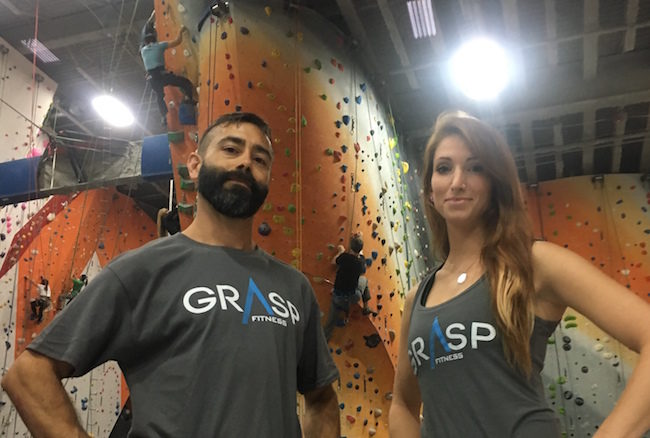
By Abree Murch
Climbing facilities around the country are choosing to partner with outside organizations to provide group fitness classes and training programs for reasons that range from simplifying logistical concerns to supplementing a lack of resources. Early last month, the Cliffs at Long Island City announced that they had formed one such partnership with GRASP Fitness with the goal of creating a one-stop shop for climbers who want a comprehensive approach to training .
What is GRASP?
GRASP Fitness was born as a previous fitness/training company called First Ascent Fitness, which began to be phased out of the Cliffs earlier this year. Dan Boterashvili, who had been a First Ascent trainer at the Cliffs for a year and a half, co-founded GRASP in order to continue providing climbers with a science-based approach to training.
“I got bit by the climbing bug about three and a half years ago and I started to notice that there was a pretty big gap when it comes to training for this sport,” Boterashvili told CBJ. “When you look at other sports like basketball, baseball, or soccer, they all have very science-based training approaches. So when we began training climbers here, we started using the Functional Movement Screen (FMS), which is one of the industry standards as far as observing people’s quality of movement and risk of injury.”
The success of this approach helped tailor GRASP’s mission. “We decided our training focus was going to be on not only being optimal for life, but also optimal for their sport – primarily rock climbing and outdoor/action sports,” Boterashvili says.
How the partnership works
While GRASP resides entirely within the Cliffs, it still retains its status as a separate entity. Kary Williams, general manager of the Cliffs, explains, “ Our goal is to make it a seamless and comprehensive partnership.”
“The agreement we have is that GRASP will focus on all of the climbing-related training, and the Cliffs will provide the coaches for climbing technique and skill-building,” Boterashvili adds. The Cliffs already had some successful fitness programs and GRASP built off of them with additional classes like Pilates and Climber Flexibility, as well as bouldering- and lead-specific group training. The company is also developing a program where a GRASP trainer works side-by-side with the Cliffs’ climbing coaches.
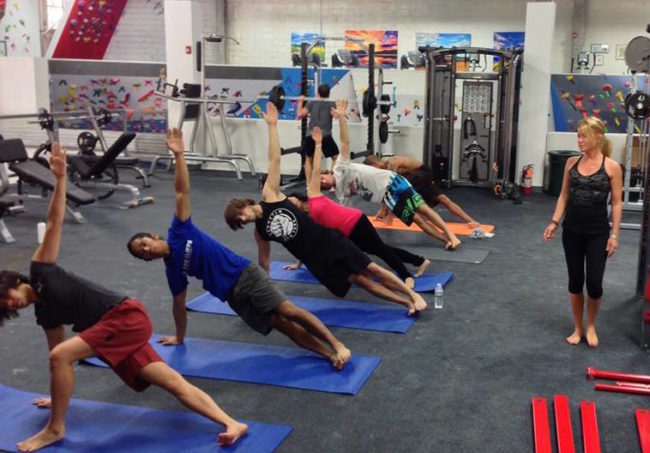
GRASP also handles yoga instruction at the Cliffs. Instructors are brought on through GRASP, who makes sure they’re certified, insured, and meet with GRASP’s climber-focused philosophy, saving the Cliffs’ management time they would otherwise spend sorting through the details. Boterashvili noted that all of their instructors are climbers. “Again, we’re focused on taking that yoga knowledge and applying it specifically to climbing and the outdoors,” he said.
On for their part, GRASP isn’t focused on building business outside of the Cliffs. In fact, the only way to work with GRASP is through the programs at the Cliffs. “We know we have a great community here, and right now, we have a lot of work to do to build the company and make our programs as strong and robust as possible,” says Boterashvili.
The decision to outsource
So why not do the program in-house? Williams says it comes down to quality. “We’ve been doing this long enough that we realize we do climbing really, really well. It’s our best in class product – but when you come into the facility, the expectation is that you get a best-in-class product no matter what you’re doing.”
The goal was to bring someone on who matched the Cliffs’ level of passion for fitness and training for climbing. It helped that GRASP was already a part of the community and was well-prepared to tailor their classes to climbers’ needs.
Williams also cites the need to stand out in a crowded market, “Being in New York, there’s so much competition between all the fitness and health clubs. Anything we can do to differentiate ourselves is a good thing. Partnering with GRASP creates a one-stop shop – you can accomplish everything right here.”
Bumps in the road
The partnership is not without its challenges, most of which stem from the fact that GRASP is a young, growing company that was built from the ground up. At the outset, both entities had to take a step back and account for aspects of the partnership that weren’t in place when it was First Ascent.
“We didn’t have very strong lead-generation systems, we didn’t have a cohesive mission as a company, and when we started GRASP, we took a look at those holes and realized we needed to make sure we worked with the Cliffs to fill them,” Boterashvili explains. Free fitness consultations are now offered to every new member, who can opt-in to be contacted by GRASP on their membership contract. GRASP and the Cliffs also created a system to organize leads and clients by their interests and needs.
On GRASP’s end, hiring trainers who understand the climbing world has also proven to be tricky: “We’re looking for more trainers who have the science-based, industry background that understand movement, injury prevention, skill acquisition, and problem solving, but who are also climbers and outdoorsmen.”
A synergistic relationship
Boterashvili sees the sense of community that draws so many people to climbing as an asset to both GRASP’s training programs and its partnership with the Cliffs. “The amount of support we have is unbeatable. Everyone at GRASP is excited to work with the Cliffs’ members and employees every day. It’s such a positive place to be in and I think that will be a huge contributor to people’s training,” he says.
The arrangement also helps hone GRASP’s unique approach to what Boterashvili acknowledges is a non-traditional training market. “The conventional training world is focused on catering to the people with the purchasing power, who can afford the luxury of personal training. We do focus on one-on-one training, but one of our primary goals is to create programs and products for people who can’t afford that one-on-one approach, like youth climbers.”
One way GRASP caters to this particular demographic is by bringing the training process online. They’ve developed a mobile app that allows members to access their custom training programs without having to enroll in one-on-one training sessions. Boterashvili sees this approach as the solution to major problems for people in the sport, knowing that, unfortunately, “a lot of climbers, especially the youth, can’t necessarily afford the services of a professional trainer outright, because it’s very expensive.”
Regardless of the high-tech approach, the goal to create an all-inclusive climbing fitness experience remains consistent. As Boterashvili puts it: “A lot of people are really excited because we can tap into this amazing thing we can do as human beings, we’re all working as a team, and we can see everyone grow.”
The 2017 Grip List Awards

This is CBJ’s fourth annual list of the most sought after climbing hold companies that are distributing their wares in North America as voted on by those who use their goods everyday, the routesetters.
This year’s Grip List was unique in several ways. We saw the rise of what could be a new era in volume making. We also saw two very different types of hold companies top the list: one a brash, sensitive genius on the bleeding edge of innovation and the other, a no-frills hold merchant prone to southern hospitality.
We only give awards to the top five Official Selections, Favorite Volume and All-Time Favorite. But we want to give credit where credit is due. That’s why we want to tell you the top ten favorite hold companies that setters voted on. Coming in at #10, with help from Cryptochild’s amazing Bubbies volumes is So iLL Holds. We know this is a bit awkward for Mark Bradley but his new stalwart of the hold room, Working Class is in a dead heat with Kingdom Holds for #9 and #8. At #7 is the definition of classic, Teknik Handholds. And racing up the list, and just out of reach of an Official Selection, is Cheeta Holds at #6.
Now to the awards!
Click or scroll down to see the awardees:
Dimension – eGrips – Element – Flathold – Kilter – Rock Candy – Teknik

Dimension Volumes
Many setters think they can make wood volumes at home, but creating quality construction that can withstand the abuse of a commercial environment takes a professional approach that few can mimic in their garage. By using lightweight fiberglass reinforcement on the inside of each panel joint, Dimension has created some of the lightest and strongest volumes money can buy.
But when it comes to wood volumes, texture is everything. Too many of today’s volumes, whether wood or fiberglass, have either a slippery yet bomb-proof texture or a texture that comes off with the first few passes with a pressure washer. According to Dimension’s sales rep, Louie Anderson, “Dimension’s texture mix hits a perfect blend of durability, ability to hold chalk, all without an aggressive texture.”
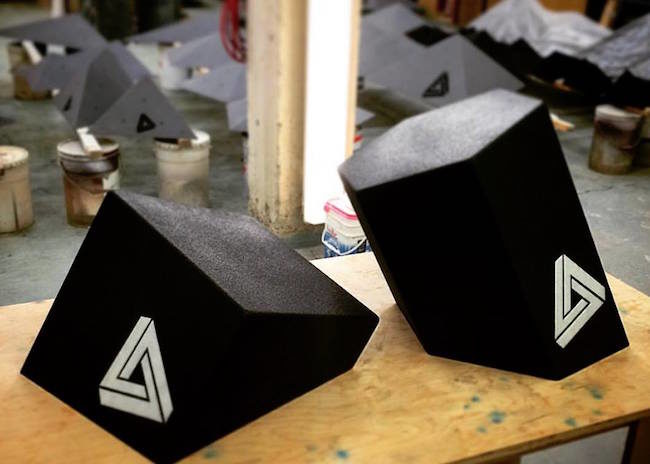
Anderson isn’t the only one that likes the texture. Ben Winstanley, Head Setter at Wallnuts Climbing Center commented that Dimension has the “best and longest lasting texture I’ve seen on volumes in over 15 years of commercial routesetting and indoor climbing.”
The whole point of volumes is to dramatically change the angles of a given wall, allowing the climber a new way to move up a route. Feeney, and his one part-time employee, have built 101 different volume shapes that do just that. Available either as bolt-on or screw-on and in sizes large and extra-extra large, these volumes are truly changing the dimension of indoor climbing.
Competitors Note: Nipping at the heels of Dimension is Blocz, which was 2 percentage points away from first place. Blocz is a German-based and US-distributed volume maker that produces very similar models as Dimension. For years, up until now, wood volumes had been dominated by Texas-based Motivation. Now with these two newcomers on the market, setters will start to see some serious competition which should drive innovation up and costs down.

Teknik
The award for All-Time Favorite hold company goes to Teknik for the fourth year in a row! The venerable Canadian hold company is still capturing the hearts and minds of setters with their classic shapes and this year is no different.
Celebrating their seventeenth year in business, Teknik has developed such a deep back catalog of shapes that, as Blake Green, Head Setter at Highpoint Climbing commented, “It’s hard to imagine opening a new gym without a large volume of Teknik shapes. The company is so ubiquitous.”
To some climbers, grips are just utilitarian pieces of the wall. But to others it was Teknik’s shapes that were so inspiring that they changed people’s lives: “They were the first company to open my eyes to pursuing pulling on plastic as an end unto itself.” wrote one Grip List voter.
When CBJ asked Teknik Founder, Seth Johnston, what they did this year that they could attribute to their ongoing success, Johnston responded, “We were just ourselves, really. Making the holds we have in us to carve and continuing to implement our standard of customer service to all those we do business with.”
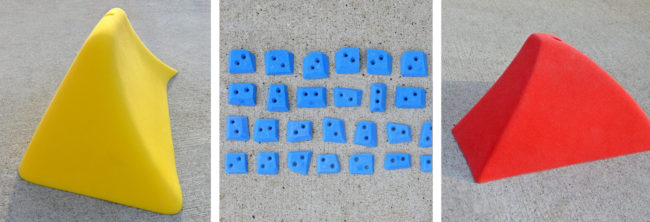

eGrips
Even after twenty years in the game, eGRIPS, led by Ty Foose and his impeccable, precision shaping, is still at the top of their game. They bumped up one spot on the Grip List this year with the help of some amazing shapes.
One example of this is the “Wings” series which comes in “parrot” and “falcon” (with rumors that a “condor” could be coming). The craftsmanship and detail on these holds is amazing to behold and is unparalleled in the industry. Foose also put out a number of very cool shapes that could stand alone but are benefited by the addition of the iconic “bubble wrap” texture.
“Setters have been asking me for many years to do more 2-Tex Bubble Wrap shapes, and to make large Bubble Wrap features. While I was in Wisconsin last January for the USAC Bouldering Nationals, I was finally talked into it by the very insistent Nationals setting crew. I knew it would be a huge undertaking to combine big, bubbly and glossy smooth all into one. Hand carving all those individual bubbles on a giant shape takes long enough, let alone creating a perfectly polished surface on all the other sides. It took the better part of 10 months for us to produce those 7 shapes, but I’m really excited about how [they] turned out.” – Ty Foose
Rock Candy
Their unwavering support of routesetters has been the backbone of what Rock Candy is all about since they opened shop ten years ago. And this year, that support helped maintain Rock Candy’s position on the Grip List at number four.
Coming straight out of Akron, Ohio this family operation has been focusing on giving setters the right tools to make their job easier. Rock Candy knows where to put their effort, from original shapes by Nathan Yokum himself to a lifetime guarantee on power bits to a streamlined ordering form.
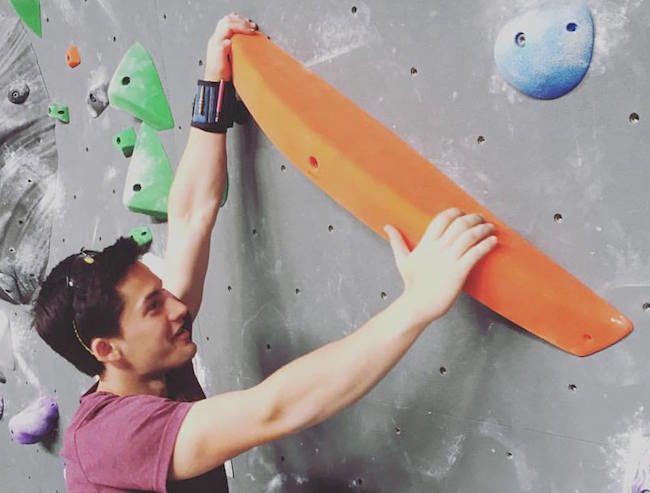
The Rock Mill, which opened in 2016, is Rock Candy’s very own bouldering gym and allows Yokum to test out shapes but, “more importantly routesetting itself,” he told CBJ. This focus on the craft and profession of routesetting has led the company to put out a “Support Your Local Setter” campaign. The program is aimed at providing setters with new holds for competitions at no cost. If the setters like what they set with they can then buy the holds at a discount.
This year Rock Candy introduced their “Colossal” size which is their biggest and by big, we mean HUGE!
“Some of their new shapes have become my instant favorites. The Diatoms are simply amazing holds and my favorite shapes I’ve seen come out this year. Also, colossal shapes like the Blockus and the Dimples are visually stunning and lend themselves to really good movement. Rock Candy just keeps on getting better!” – Quinn Kellogg setter at Vertical Adventures.
Flathold
If there was a cool kid of the climbing hold world, it would be Flathold. Led by an Internationally known setter with connections to the strongest climbers on the planet, Manu Hassler and Mathieu Achermann, with their smooth texture and original urethane shapes, have mastered the art of Swiss-cool.
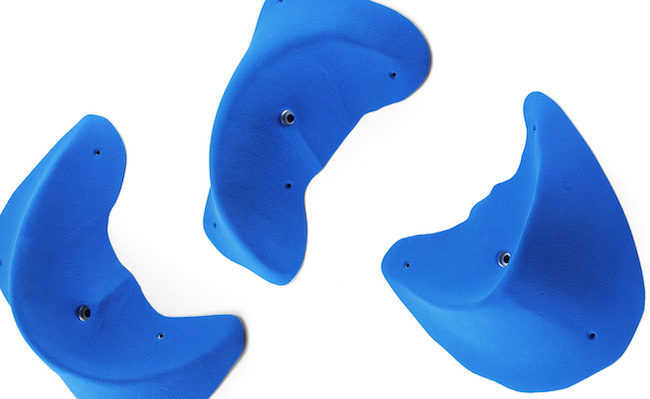
Their highly recognizable volume and screw-on shapes are some of the most sought after on the market. “Flathold has this amazing knack for producing practical climbing holds with all the aesthetic appeal of your favorite Jackson Pollock.” Andrew Shoemaker Setter at Cirque in Olympia, WA commented.
Achermann told CBJ that he and Hassler spent the year shaping about 350 new holds and nine new volumes which will be released sometime in 2017. He said the team has been more focused on working out new ideas and, “taking time in the workshop to develop new shapes and trying to stay inspired.”
For this past year, Flathold put out eighty-three holds that make up the new “Tokyo 2020” set which many of the voters commented on. “Amazing”, “excellent”, “fabulous”, were just a few of the adjectives used to describe the set.
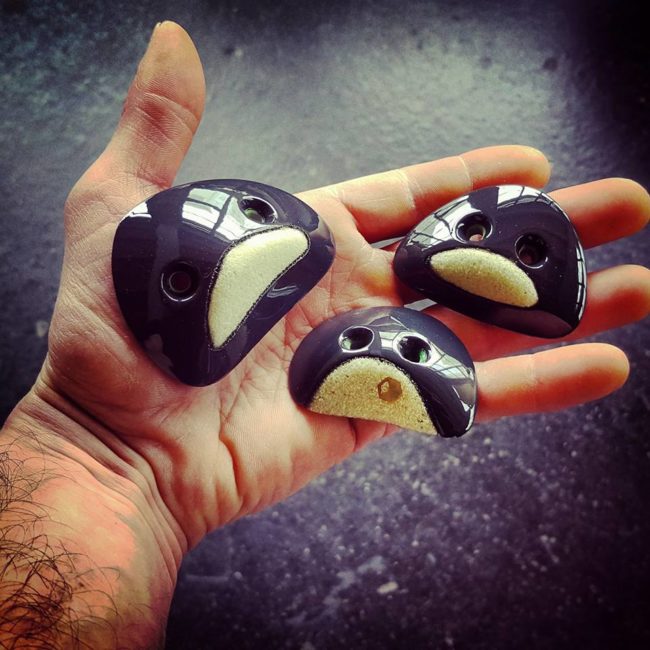
Flathold has one of the smaller total line-ups of any company but they have brought to market features that setters have been wanting: washers for set screws, and plugs for bolt holes and now they’re starting to perfect their dual-tex.
Flathold has only been distributed in America for a year but has already made a serious impression on setters. Get ready to see more of Flathold as they just signed on as an official USAC National sponsor, “It is just a beginning for us in the North American market,” Achermann said.
Element
Wow, what a year Element has had! They released 170 new holds, took Catalyst, their hold pouring division Nationwide and signed up eight brands, sponsored the new National Cup series and became an official USA Climbing hold sponsor, and brought on legendary hold shaper Louie Anderson to be their US sales rep. AND they lept from fifth place in last year’s Grip List up to second place this year!

One reason for the jump in position could be the amount of time and money owners David and Lisa Filkins have put towards making sure everyone knows about Element. His marketing could be seen at the annual CWA Summit last spring. The Element logo was everywhere in the venue along with a savvy campaign to get the word out about Catalyst. Sponsoring the Setter Showdown, which gets holds directly into the hands of setters, and the new opportunity that national exposure will bring them when they debut their grips at the USAC Bouldering National Championship this winter is sure to keep the Element team busy.
Even more than the marketing, or the hold selection or even the low prices, what seems to separate Element from the rest of the competition is their absolute maniacal focus on customer service. Element had more diverse voting than any other hold brand. They received votes from every aspect of the hold buying universe; from commercial head setters, university wall setters and even home woody buyers.
Kilter
Ian Powell’s obsession with artistry balanced with his innate desire to create ground-breaking designs is why Kilter takes the Grand Prize in this year Grip List. And just like last year, Kilter dominated the voting, taking 34% of all votes tallied (the next closest was 7%).
The company is only three years old but is already knocking on the door of All-Time Favorite hold company (watch out Teknik!). They are doing this in two ways. First, by sheer brute force: the amount of holds that Kilter puts out in one year is more, by far, than any company on the Grip List. This year alone they put out over 225 new shapes, most of them in the overwhelmingly popular Sandstone series, “[The] sandstone line is amazing and the dual tex versions are jaw dropping incredible,” wrote one Grip List voter.
Second, by pushing the level of artistry to new levels. There are only a handful of people in the world that can hold a candle to what Powell can do with foam. The way he can turn foam into works of art beguiles his burly bodily dimensions and his brusque demeanor. Though he has a tendency to come across as a playground bully online, we imagine that once alone, he whispers the sweetest nothings to get the foam to release its secrets.
“The quality of these holds is just on another level. Subtle shapes, beautiful aesthetics, and amazing texture.” – Max Robertson, Routesetter at Gravity Climbing Gym
It’s not just Powell’s shapes that setters are eating up; the “Lowriders” by pro-setter Jeremy Ho, “Puccio Pinches” by Alex Puccio and Jimmy Web’s “Southern Slopers” all garnered a lot of attention this year. All these shapes come from Kilters “Haptic” line which are shaped by a unique collection of professional routesetters and climbers.
“Good mix of young and experienced shapers pushing the hold industry into a new and exciting age.” – Cody Grodzki, Head Setter at High Point.
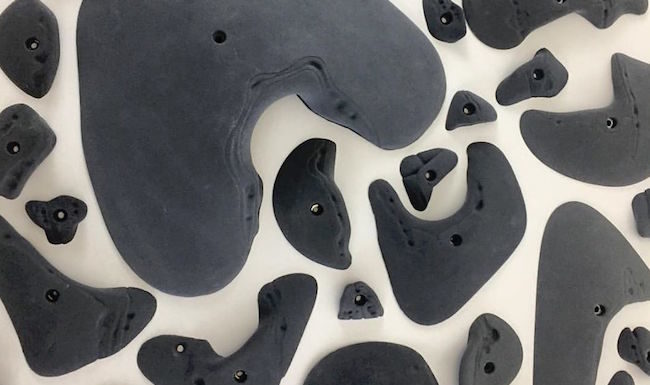
Many hold companies think they are being innovative but Kilter is one of the few that actually is. And this coming year we could see that in full effect when they release the much touted “Stacks”. Climbing walls are flat and thus climbing holds have a flat back. But with the proliferation of volumes the climbing wall now has 3D dimensions allowing for the possibility of melding a hold to a volume. The Stacks will have the ability to “bend” 2 – 3 degrees to match up to the corresponding volume angle.
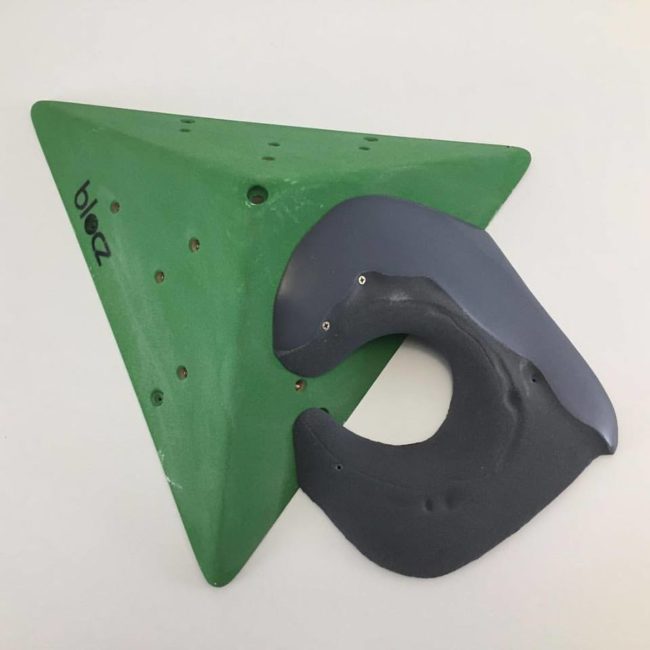
“Stacks are a lot more than a simple gimmick. I’ve come to see them as a necessary connector between planes all over gyms and something that volumes needed to tie them to walls more elegantly. It’s one of those designs that you didn’t realize was so valuable until you see them and then it clicks. I’ve been working on them for a few years now so at this point walls without them have started to look a touch simple to me. Hopefully, the market agrees with me and starts to feel the same way.” – Ian Powell told CBJ




